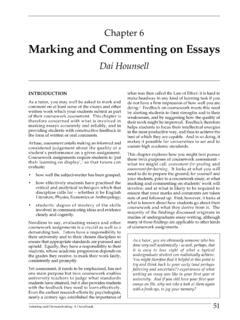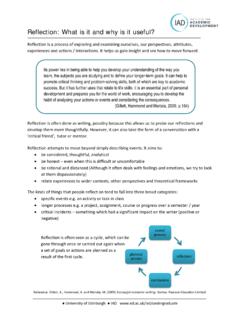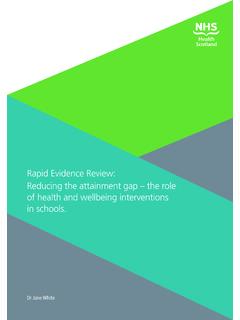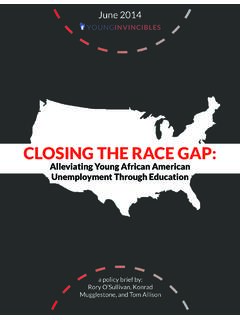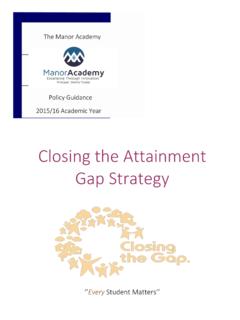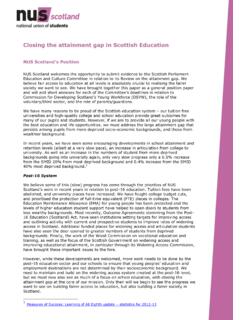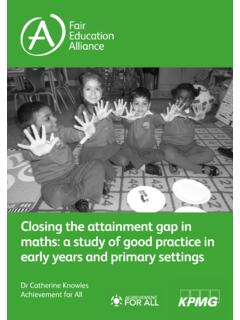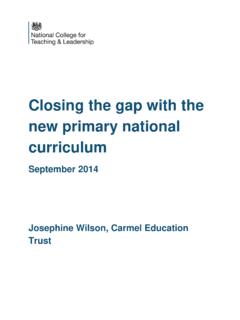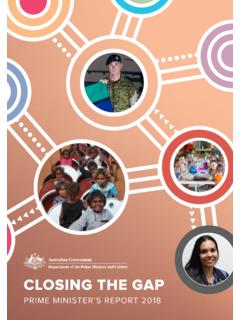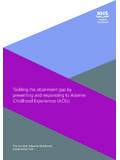Transcription of Closing the gap in attainment in Scottish schools
1 Closing the gap in attainment in Scottish schools Closing the gap in attainment in Scottish schools : Three challenges in an unequal society Dr Gillean McCluskey 7 December 2015. Improving school attainment is arguably the single most important objective in this programme for Government'. (First Minister Nicola Sturgeon 2014). Why is this such a concern? children living in the most deprived areas in Scotland are 6 to 13 months behind their peers in problem-solving at age 5; 11 to 18 months behind their peers in expressive vocabulary at age 5; and around two years of schooling behind their peers at age 15'. ( Scottish Government 2014, p5). Child Well-Being in Rich Countries: UNICEF 2013. Scottish policy context Concern about PISA scores Policy responses Raising attainment for All' (2014). Access to Education Fund attainment advisors national network Increasing use of data in schools appointment of Scotland's first Independent Poverty Advisor in June 2015 (Naomi Eistenstadt).
2 Appointment of advisor to Scottish Government on the attainment Challenge in Oct 2015 (Prof Chris Chapman of Glasgow University). National Improvement Framework (draft 2015). Three challenges Raising attainment Closing the gap in attainment Holding these in aims in balance Defining the gap reducing the link between deprivation and poor educational attainment in Scotland'. What do we know about the gap? More than one in five children (210,000) children in Scotland live in poverty. children living in the most deprived areas in Scotland are 6 to 13 months behind their peers in problem-solving at age 5; 11 to 18 months behind their peers in expressive vocabulary at age 5; and around two years of schooling behind their peers at age 15' ( Scottish Government 2014, p5). By the time that children leave primary school (usually around age 11), those in receipt of free school meals are estimated to be three times behind their more affluent peers (Child Poverty Action Group, 2015).
3 The power of affluent parents The glass floor'. Opportunity hoarding'. (Reeves and Howard, 2013, McKnight 2015). Finding new guidewires'? student participation home- school relationships behaviour and relationships in school Student participation Children report that their views are not sought, listened to or acted upon consistently. There is good evidence of the negative outcomes for children that emerge when they are unable to have their voices heard. Only a minority of school Councils have been involved in making important' decisions What might look like low aspirations' may often be high aspirations that have been eroded by negative experience BUT increased student participation can lead to improved outcomes Home- school relationships What might look like low aspirations' may often be high aspirations that have been eroded by negative experience What might look like parental disengagement' may actually be the result of a high level of commitment to their child's education, which is not matched by the capacity to provide effective support or.
4 By the ability of schools to work effectively with parents BUT helping poorer parents to believe in their own actions and efforts can lead to improved outcomes Behaviour and relationships in school Evidence from research on Restorative approaches Solution focused schools Exclusion/suspension from school (Nurturing approaches). Who gets excluded? Mental health No parent in work difficulties Teenage parenthood Physical and/or Poor basic skills learning difficulties Living in poor housing Substance misuse Looked after'. Domestic abuse Financial stress Conclusions Need to look again at the familiar: To acknowledge the robustness of the evidence base in each of these three areas of interest To recognise the contribution of these three areas of research and invest in each To develop the connections between these three areas of research as a way to generate new knowledge, and foundations for change, and synergies of hope?
5 References Bradshaw, P. (2011) Growing Up in Scotland: Changes in child cognitive ability in the pre- school years. Edinburgh: Scottish Government. Carter-Wall, C. and Whitfield, G. (2012) The role of aspirations, attitudes and behaviour in Closing the educational attainment gap. York: Joseph Rowntree Foundation. Macleod, G., Pirrie, A., McCluskey G. and Cullen, (2013) Parents of excluded pupils: customers, partners, problems? Educational Review, (4), Mannion, G. Sowerby, M. and I'Anson, J. (2015) How young people's participation in school supports achievement and attainment . Edinburgh: Scotland's Commissioner for Children and Young People. McCluskey, G., Brown, J., Munn, P., Lloyd, G., Hamilton, L. Macleod, G. and Sharp, S. (2013) Take more time to actually listen': students' reflections on participation and negotiation in school British Educational Research Journal, Vol.
6 39(2), pp. 287-301. McKnight, A. (2015) Downward mobility, opportunity hoarding and the glass floor'. Research report. London: Social Mobility and Child Poverty Commission. Pirrie, A. and Hockings, E. (2012) Poverty, educational attainment and achievement. Edinburgh: Scotland's Commissioner for Children and Young People. Reeves, R. and Howard, K. (2013) The glass floor: education, downward mobility and opportunity hoarding. Washington DC: Brookings Institution, Center on Children and Families at Brookings Scottish Government (2014) Raising attainment for All. Scotland; the best place in the world to go to school . Edinburgh: Scottish Government Spencer, S. (2015) The cost of the school day. Glasgow: Scottish Poverty Action Group in Scotland.


